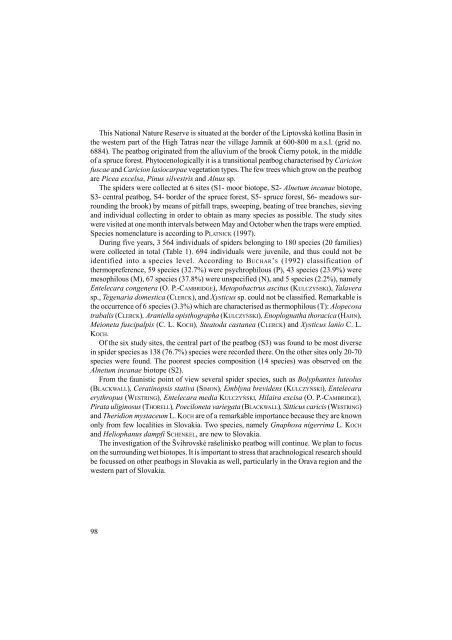spiders (araneae) of the fishpond eulittoral zone - European Society ...
spiders (araneae) of the fishpond eulittoral zone - European Society ...
spiders (araneae) of the fishpond eulittoral zone - European Society ...
Create successful ePaper yourself
Turn your PDF publications into a flip-book with our unique Google optimized e-Paper software.
This National Nature Reserve is situated at <strong>the</strong> border <strong>of</strong> <strong>the</strong> Liptovská kotlina Basin in<br />
<strong>the</strong> western part <strong>of</strong> <strong>the</strong> High Tatras near <strong>the</strong> village Jamník at 600-800 m a.s.l. (grid no.<br />
6884). The peatbog originated from <strong>the</strong> alluvium <strong>of</strong> <strong>the</strong> brook Čierny potok, in <strong>the</strong> middle<br />
<strong>of</strong> a spruce forest. Phytocenologically it is a transitional peatbog characterised by Caricion<br />
fuscae and Caricion lasiocarpae vegetation types. The few trees which grow on <strong>the</strong> peatbog<br />
are Picea excelsa, Pinus silvestris and Alnus sp.<br />
The <strong>spiders</strong> were collected at 6 sites (S1- moor biotope, S2- Alnetum incanae biotope,<br />
S3- central peatbog, S4- border <strong>of</strong> <strong>the</strong> spruce forest, S5- spruce forest, S6- meadows surrounding<br />
<strong>the</strong> brook) by means <strong>of</strong> pitfall traps, sweeping, beating <strong>of</strong> tree branches, sieving<br />
and individual collecting in order to obtain as many species as possible. The study sites<br />
were visited at one month intervals between May and October when <strong>the</strong> traps were emptied.<br />
Species nomenclature is according to PLATNICK (1997).<br />
During five years, 3 564 individuals <strong>of</strong> <strong>spiders</strong> belonging to 180 species (20 families)<br />
were collected in total (Table 1). 694 individuals were juvenile, and thus could not be<br />
identified into a species level. According to BUCHAR’S (1992) classification <strong>of</strong><br />
<strong>the</strong>rmopreference, 59 species (32.7%) were psychrophilous (P), 43 species (23.9%) were<br />
mesophilous (M), 67 species (37.8%) were unspecified (N), and 5 species (2.2%), namely<br />
Entelecara congenera (O. P.-CAMBRIDGE), Metopobactrus ascitus (KULCZYŃSKI), Talavera<br />
sp., Tegenaria domestica (CLERCK), and Xysticus sp. could not be classified. Remarkable is<br />
<strong>the</strong> occurrence <strong>of</strong> 6 species (3.3%) which are characterised as <strong>the</strong>rmophilous (T): Alopecosa<br />
trabalis (CLERCK), Araniella opisthographa (KULCZYŃSKI), Enoplognatha thoracica (HAHN),<br />
Meioneta fuscipalpis (C. L. KOCH), Steatoda castanea (CLERCK) and Xysticus lanio C. L.<br />
KOCH.<br />
Of <strong>the</strong> six study sites, <strong>the</strong> central part <strong>of</strong> <strong>the</strong> peatbog (S3) was found to be most diverse<br />
in spider species as 138 (76.7%) species were recorded <strong>the</strong>re. On <strong>the</strong> o<strong>the</strong>r sites only 20-70<br />
species were found. The poorest species composition (14 species) was observed on <strong>the</strong><br />
Alnetum incanae biotope (S2).<br />
From <strong>the</strong> faunistic point <strong>of</strong> view several spider species, such as Bolyphantes luteolus<br />
(BLACKWALL), Ceratinopsis stativa (SIMON), Emblyna brevidens (KULCZYŃSKI), Entelecara<br />
erythropus (WESTRING), Entelecara media KULCZYŃSKI, Hilaira excisa (O. P.-CAMBRIDGE),<br />
Pirata uliginosus (THORELL), Poeciloneta variegata (BLACKWALL), Sitticus caricis (WESTRING)<br />
and Theridion mystaceum L. KOCH are <strong>of</strong> a remarkable importance because <strong>the</strong>y are known<br />
only from few localities in Slovakia. Two species, namely Gnaphosa nigerrima L. KOCH<br />
and Heliophanus dampfi SCHENKEL, are new to Slovakia.<br />
The investigation <strong>of</strong> <strong>the</strong> Švihrovské rašelinisko peatbog will continue. We plan to focus<br />
on <strong>the</strong> surrounding wet biotopes. It is important to stress that arachnological research should<br />
be focussed on o<strong>the</strong>r peatbogs in Slovakia as well, particularly in <strong>the</strong> Orava region and <strong>the</strong><br />
western part <strong>of</strong> Slovakia.<br />
98
















